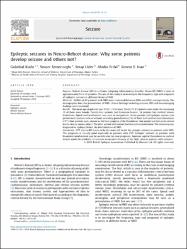Epileptic seizures in Neuro-Behcet disease: Why some patients develop seizure and others not?
Abstract
Purpose: Behcet disease (BD) is a chronic relapsing inflammatory disorder. Neuro BD (NBD) is seen in approximately 5% of all patients. The aim of this study is to investigate the frequency, type and prognosis of epileptic seizures in different forms of NBD. Methods: All files of 42 patients with NBD were evaluated between 2006 and 2012, retrospectively. The demographic data, the presentation of NBD, clinical findings including seizures, EEG and neuroimaging findings were reviewed. Results: The mean age of patients was 35.02 +/- 8.43 years. Thirty (71.4%) patients were male; the remaining 12 of them were female. Twenty-four patients had brainstem lesions; 16 patients had cerebral venous thrombosis. Spinal cord involvement was seen in two patients. Seven patients had epileptic seizures (six partial onset seizures with or without secondary generalization). Six of them had cerebral sinus thrombosis (CVT). Four patients had a seizure as the first symptom of the thrombosis. One patient had late onset seizure due to chronic venous infarct. The other patient with seizure had brainstem involvement. The remaining was diagnosed as epilepsy before the determination of NBD. Conclusion: CVT seen in BD seems to be the main risk factor for epileptic seizures in patients with NBD. The prognosis is usually good especially in patients with CVT. Epileptic seizures in patients with brainstem involvement may be an indicator for poor prognosis. Superior sagittal thrombosis or cortical infarct would be predictor of seizures occurrence because of the high ratio in patients with seizures. (C) 2015 British Epilepsy Association. Published by Elsevier Ltd. All rights reserved.


















